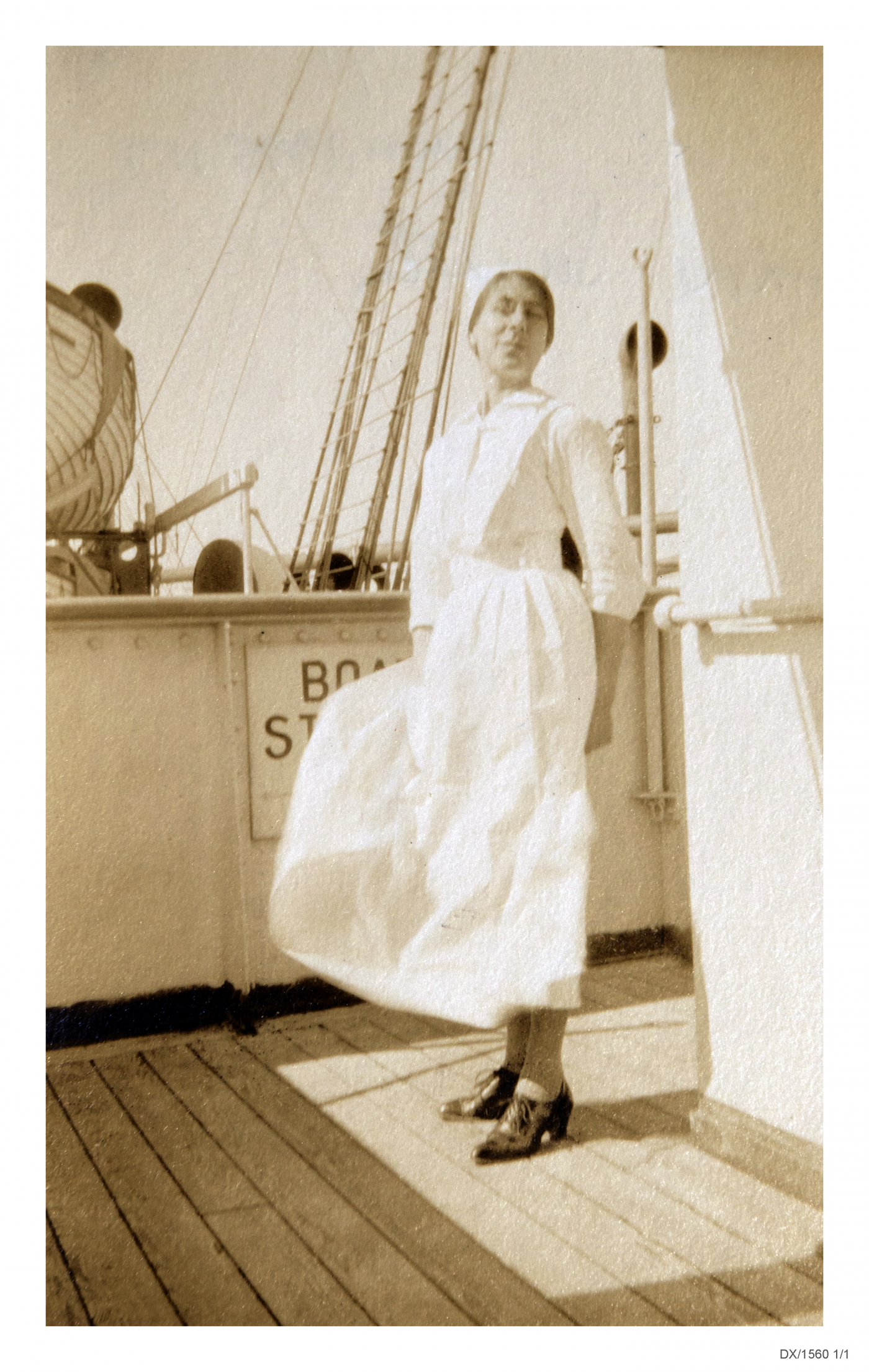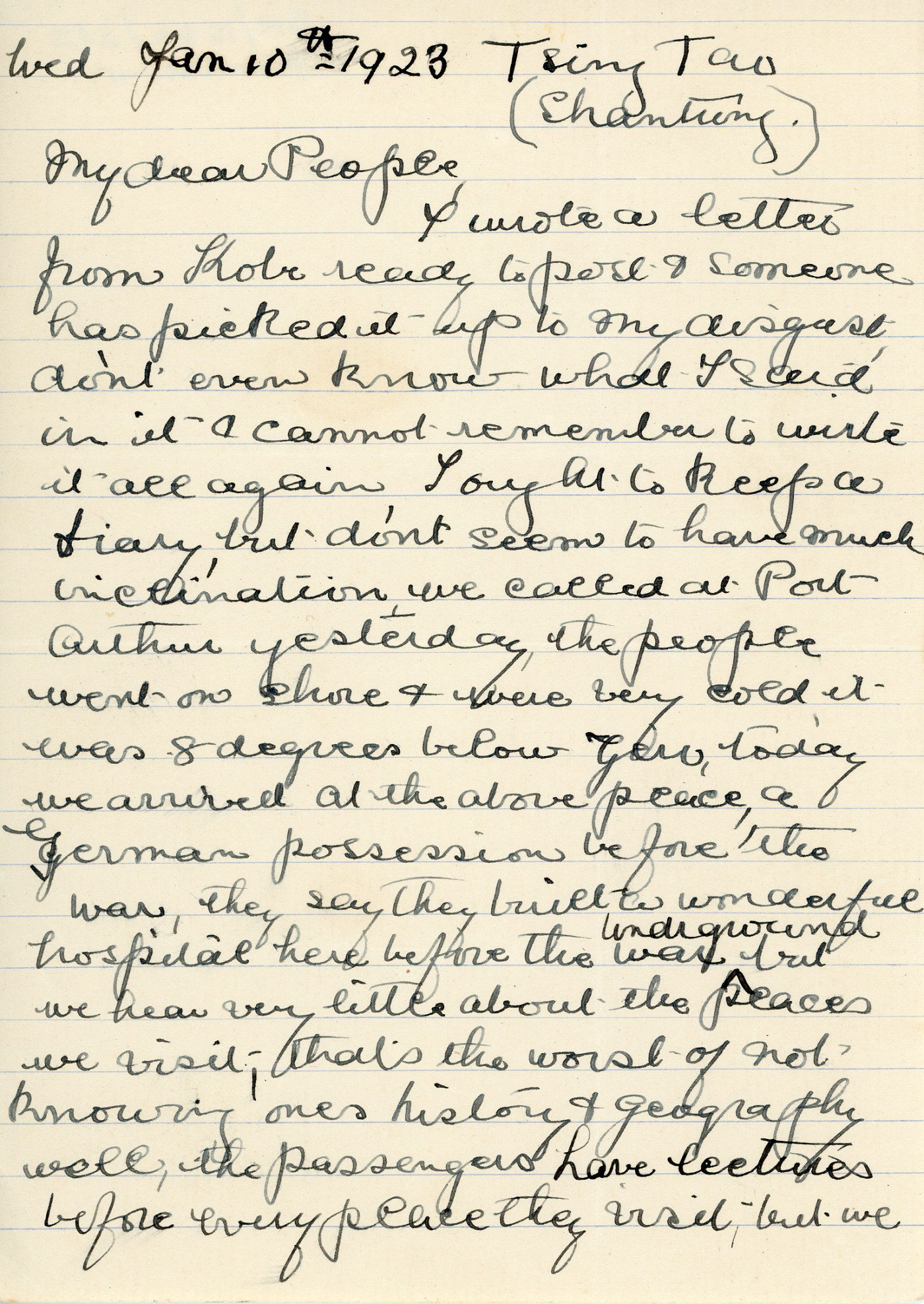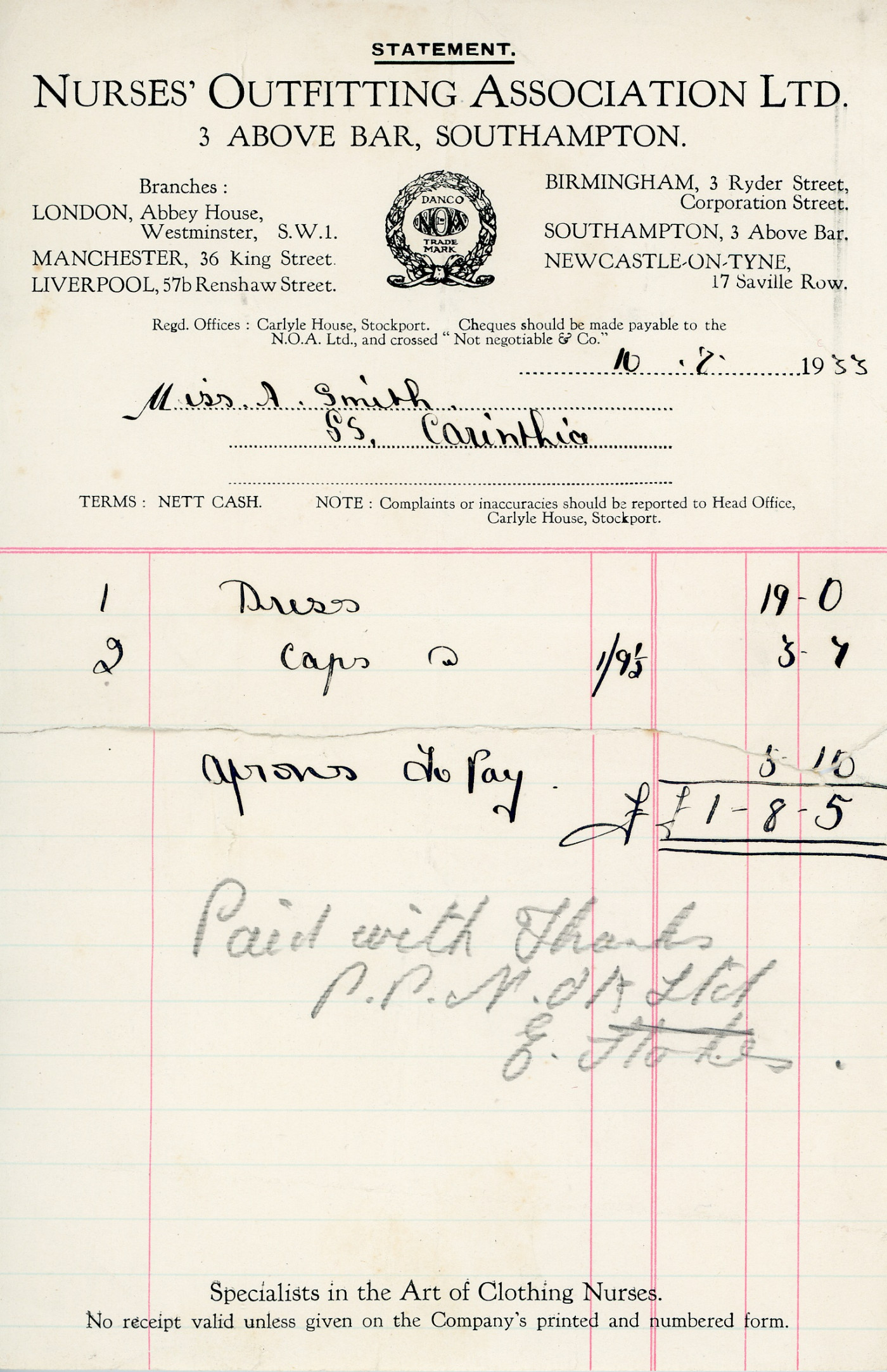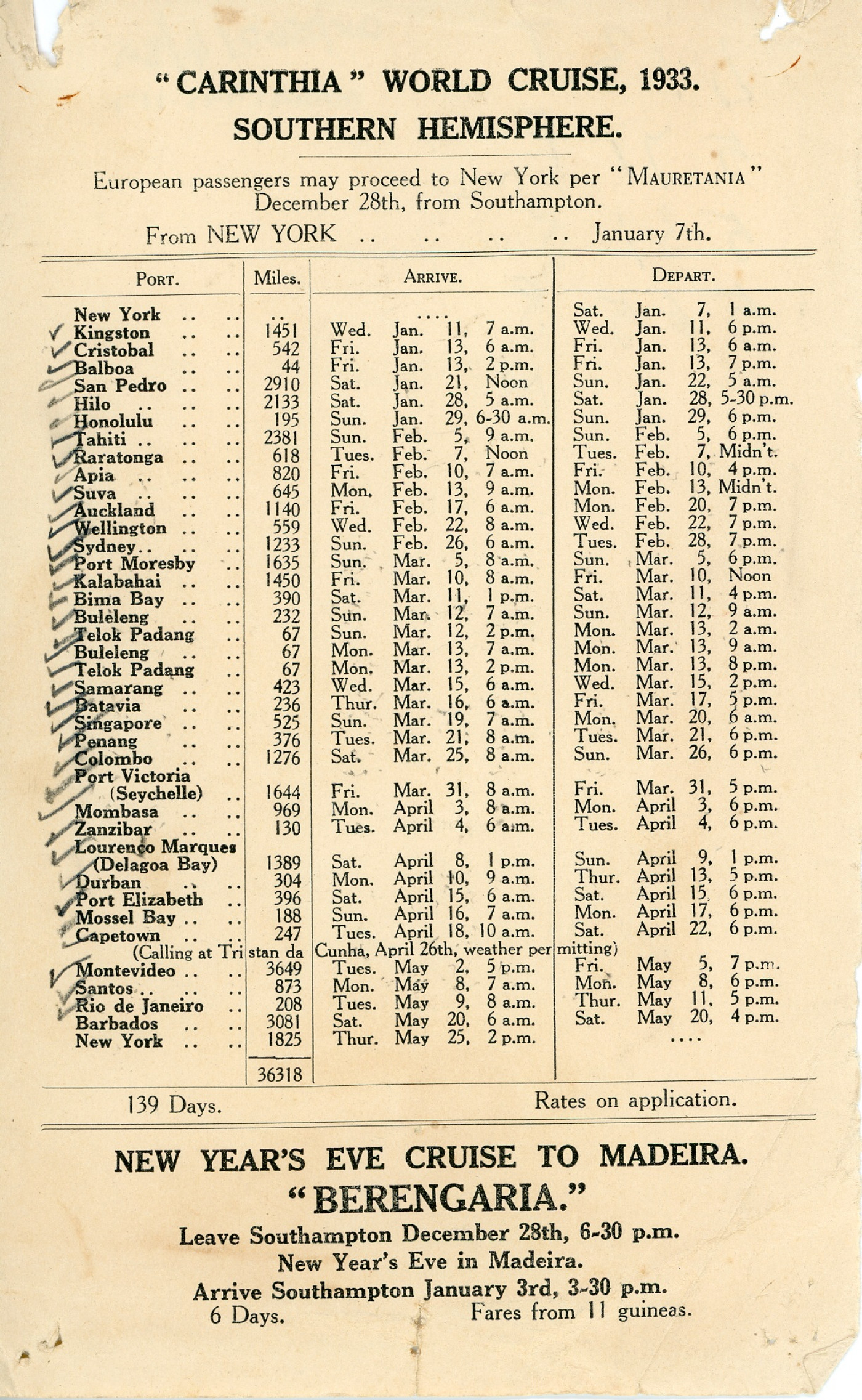This article was written for the Rewriting Women into Maritime inititative by Sarah Starkey, Lead Archivist, Maritime & Slavery Collections for The Archives Centre, National Museums, Liverpool.
Anne Smith, c.1922-1930s
Stewardess

Photograph of Anne Smith in Stewardess uniform on board unidentified vessel, no date, around 1922-1933. DX/1560/1/1. © The Archives Centre, National Museums Liverpool
‘My dear people...’ stewardess, Anne Smith, begins her letters home and ends them with a request that the recipient passes the letter on ‘I am sending this to Grace & perhaps she will be good enough to forward to Lucy amongst my other papers, that is all letters I may send’ (DX/1560/2/1). The writing and receiving of letters on long voyages is a matter of careful timing and sometimes Anne doesn’t have time to read incoming letters before having to get her letters posted ‘This morning I had handed to me letters from Grace Lucy & Uncle Mountain but have not had time to open them yet hope to do so shortly but in mean time must get this posted’ (DX/1560/2/6).

Example page from a letter by Anne Smith to her family, 10 January 1928. DX/1560/2/5. © The Archives Centre, National Museums Liverpool
Fortunately a group of Anne’s letters home survived the various brushes with disposal that faces all documents during their path to being donated to an archive. The Archives Centre at the Maritime Museum, Liverpool holds a small collection of 10 letters, 2 diary notes, 5 photographs and a few other papers relating to Anne’s seafaring career at our reference number DX/1560. They were donated to us in 1995 with no additional information, but can still provide information about the life of a woman working at sea.
Although, actually, Anne doesn’t particularly dwell on her work, she is more interested in the ports she is visiting and the wonderful sights she sees on the voyage. This may be because she wants to present a successful version of herself to her family, but mainly it seems to be that this is where her interest lies. Anne wants to be a globe trotter and in the absence of enough money, has become a stewardess.
‘The streets in the Orient are always full of interest, teeming with humanity & every place has something of interest, I should like to go round the world leisurely say in a yacht with a nice party & of course one would need lots of money any-how this way is better than nothing so must not grumble’ (DX/1560/2/6).
She gives the impression that she would make a keen and attentive tourist ‘we hear very little about the places we visit; that the worst of not knowing ones history & geography well, the passengers have lectures before every place they visit, but we don’t have that privilege’ (DX/1560/2/5) and appears to take every opportunity given to leave the ship and explore ashore. Although work and her gender do constrain her attempts ‘I went on shore twice at Yokohama but being alone did not see much, was afraid to go far afield, unfortunately, when I am on Miss Kittsner is off & vice versa we being on the same deck have to relieve each other for duty’ (DX/1560/2/3).
Anne’s interest in sea travel is deep and long lasting. The collection includes a postcard of the yacht Ahola on which Anne has written ‘I sailed on this lovely yacht with the Owners Mr and Mrs Arthur Curtis James from New York to Monte Carlo, 1913 just before the 1st war broke out’. She doesn’t say in what capacity she is was onboard, passenger, crew or companion, but crossing the Atlantic on a yacht, however luxurious, is a different proposition to the large Cunard liners she is writing home from in the 1920s. The collection includes itineraries from Cunard cruises in the early 1930s and a bill for uniforms from 1933, so Anne’s career with Cunard lasts at least 10 years. It would be interesting to know whether it was ended by the Second World War or she continued to answer the pull of the sea.
Anne appears to be fairly well off and educated. Her letters are confidently written with correct spelling and grammar, and she does not appear to find letter writing a chore or a difficulty. Her comments about life at home include ‘I am glad to hear Lady Eveline is engaged to Mr. Aryles, I don’t know why! but I always thought it would be a match.’ (DX/1560/2/4) and ‘when are the tenants due to leave Holmwood, it would be rather nice if I could spend a little time there after this trip’ (DX/1560/2/7). Perhaps had the First World War not removed so many potential husbands from British society, Anne would have been travelling as a middle class passenger and a wife, but instead she is making her own way in the world and managing to combine her interest in travel with her need for employment. ‘It may sound alright to say one is working one’s passage round the ship but it isn’t all rosy & fair sailing by any means, but then hardly anyone’s life is that so must not grumble & on the whole I must be pretty lucky’ (DX/1560/2/5).
In her letters Anne writes more about the places she and the passengers visit, because that is where her interest lies. She is also trying to write in an interesting and entertaining manner to her family. Indeed she apologies for what she feels is poor content ‘I am sorry it is not as interesting as it ought to be really, but of course we have our work to do here on board not like the passengers who have all their trips planned out etc. & go off carefree with nothing to do but sight-seeing, however! beggars cannot be choosers’ (DX/1560/2/3). From a history point of view, we may wish that Anne had written more about her work on board, her relationships with fellow crew and with the passengers, but historians are not Anne’s audience, so we are left to glean what we can about her working life and what evidence that provides about the lives and work of stewardesses in general.
The collection also includes two partial diaries, which were also written to be sent home, so again were written by Anne for a specific family audience, with explanations and details that would not be include if she was writing purely for herself. Diaries appear to be a common feature of Anne’s voyages, in a letter from 1922 she writes ‘I have not yet started a diary yet but must really begin if possible’ (DX/1560/2/1) while the two diaries that are in the collection come from voyages in 1927 and 1928. While the letters say relatively little about work, the diaries, with their daily entries, reveal a little more about the day to day stresses and strains of working life and how it impacts on Anne.
These are all quotes from the diary of a voyage on the Cunard ship Carinthia, 1927-1928 (DX/1560/3/1) ‘We worked until 12 p.m. & then knocked off & had a much needed rest’, ‘very tired tonight shall be so glad to say goodbye to the passengers for a few days’, ‘The ship is very quiet, nothing much to do, I have five rooms on the go & to keep the empty rooms dusted.’ Unsurprisingly there appears to be a lot of tiring physical work, drudgery and repetitiveness involved in the work of a stewardess. Other parts of the role is attending to the needs and demands of the passengers ‘my time has been very fully occupied although only a few ladies they are very exacting, one sees human nature in its true light placed as I am, & it does not always tend to make one admire same’ (DX/1560/2/10). There is also the cross over between maid and nursemaid ‘I have a lady in bed, Mrs. Garlick, she also stayed in bed yesterday, nothing the matter but nerves all tied up in a bunch hard, dreadful really’ (DX/1560/3/1). The nursing background of the role of ships’ stewardesses is shown when Anne buys her uniform. The collection contains 2 receipts for clothing purchased by Anne in 1933; the supplier of stewardesses’ uniforms is the Nurses Outfitting Association with branches across the UK.

Receipt for uniform from Nurses Outfitting Association, 10 July 1933. DX/1560/5/1. © The Archives Centre, National Museums Liverpool
Finally, what can the collection tell us about the other women at sea on Anne’s voyages, the passengers? Anne is sailing at the top end of the cruising hierarchy. She is working for Cunard on luxury liners undertaking lengthy cruises. She visits, and writes from, a dizzying array of ports and locations around the globe, see the list of ticked off ports from the itinerary of Carinthia World Cruise, 1933 (DX/1560/4/3/1). Her female passengers are often American and have the money to undertake this type of globetrotting. ‘It does make me wonder to see these American people with such a plenty of money, but they are real good sports & seem to enjoy spending & distributing it around, anyway it is much better than hoarding it up like a good many would do’ (DX/1560/2/2). They are travelling not for business as is often the case on a transatlantic voyage, but for sightseeing, and appreciate a packed itinerary ‘Americans just must keep doing something & soon get fed up with the quietness of ships life’ (DX/1560/2/8). Cruising during the 1920s of course allowed Americans to escape the prohibition laws, this was a big selling point for shipping companies and a big attraction for passengers. ‘The passengers had a great time on board during the Xmas holidays, plenty of drink knocking about & incidentally sore heads!’ (DX/1560/2/3).

Itinerary of Carinthia World Cruise, 1933. (DX/1560/4/3/1). © The Archives Centre, National Museums Liverpool
Anne includes a few remarks about demanding passengers, but broadly seems unperturbed by their presence, except when it prevents her doing her own sightseeing, ‘I have one old lady still in bed, keeps me hanging around otherwise I could get off today, for a few hours, there is generally something’ (DX/1560/2/10). Given the means and opportunity, you feel sure she would gladly take their place. For at her heart she is a traveler, and seafaring is a means for her to achieve this end. ‘We might possibly get a chance to go to Cairo for one night from Alexandria, but must wait & see, it would be lovely to go to Cairo again although I of course have been once, no, twice before, still it calls you back’ (DX/1560/2/9).
Anne’s letters and other documents relating to her seafaring career are held at The Archives Centre of the Maritime Museum in Liverpool and are available to the public through our Searchroom. Copies of the collection catalogue and transcripts are available on request, but unfortunately not yet online.
DX/1560, Voyage Accounts and Ephemera relating to Anne Smith, Stewardness, Cunard Line.
Back to the exhibition home page.

